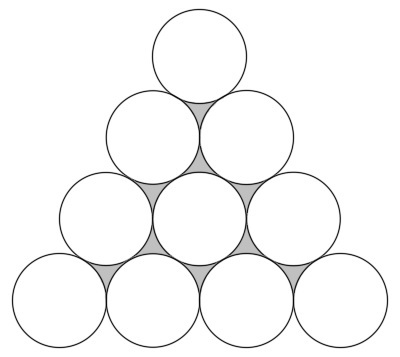tangent circles . .
 Ten identical circles are arranged as shown. If the total area of the shaded region is
, find the outside perimeter of the figure.
Ten identical circles are arranged as shown. If the total area of the shaded region is
, find the outside perimeter of the figure.
This section requires Javascript.
You are seeing this because something didn't load right. We suggest you, (a) try
refreshing the page, (b) enabling javascript if it is disabled on your browser and,
finally, (c)
loading the
non-javascript version of this page
. We're sorry about the hassle.
A r e a b e t w e e n t h r e e t o u c h i n g u n i t c i r c l e s = 3 − 2 1 π . I n t h e c i r c l e s s h o w n t h e r e a r e 9 s u c h a r e a s . S o a r e a o f e a c h c i r c l e i s a l s o = 9 9 3 − 2 9 π = 3 − 2 1 π . . ⟹ E a c h o f t h e c i r c l e s h o w n i s a n u n i t c i r c l e c i r c u m f e r e n c e 2 π . M i d d l e t w o c i r c l e s o f e a c h o f t h e t h r e e s i d e s c o n t r i b u t e h a l f c i r c l e t h a t i s π . S o t h e s e s i x c i r c l e s c o n t r i b u t e 6 π . T h r e e c o r n e r c i r c l e s h a v e 3 1 π s e g m e n t n o t o n p e r i m e t e r . S o e a c h h a s 3 5 π c o n t r i b u t i o n . T o t a l 3 ∗ 3 5 π = 5 π . S o o u t s i d e p e r i m e t e r o f t h e f i g u r e = ( 6 + 5 ) π = 1 1 π .